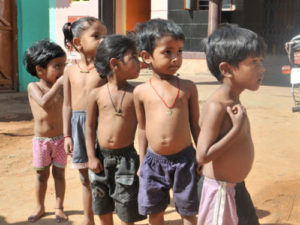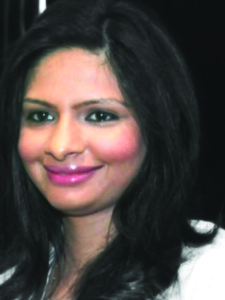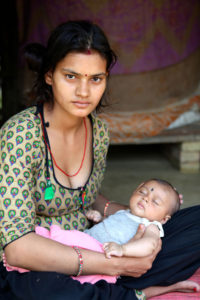Deprived Childhood
A large number of children in India suffer from malnutrition resulting in underweight and stunting. Lack of maternal education in both slum and non-slum areas increases the incidence of nutritional deficiencies that are particularly critical in the first two years after birth
By Team Double Helical
In the recent era, India has seen several advances in health care. In the late 90s, liver transplants were not done in India. The programme kicked off in 2000s, showed slow progress in the initial one decade but later multiple centres emerged in various parts of the country.
Nutritional deficiencies in India are evident right from the time of birth. Stunting and underweight rise rapidly in the first two years of life. The proportion of children stunted rises sharply from 0 to 20 months of age peaking at 59 percent.
Thereafter, the proportion of children fluctuates between 48 percent and 60 percent. The proportion of children who are underweight also rises rapidly for the first 20 months of life to 47 percent. At older ages, the proportion of underweight has a similar pattern of fluctuation as observed for stunting, but at a lower level. The proportion of children wasted rises from 24 percent in the first month of life to 32 percent at one month of age, and generally declines thereafter.
About one out of every six children age 38-57 months is wasted. The decline in wasting with age is a result of the more rapid increase in stunting than in underweight with increasing age. The first two years of life is a critical period in the growth and development of children, but it is clear that nutritional deficiencies generally worsen during that period.
In response to this age pattern found in earlier National Family Health Surveys (NFHS) as well, the Government has reoriented its Integrated Child Development Services (ICDS) programme, expanding the programme from its almost exclusive focus on children age 3-6 years to include younger children. However, children in India continue to suffer from serious nutritional problems during the early childhood years. Good child care practices are influenced by the mother’s education.
In India, 49 percent mothers of children under five years of age have never attended school and only 9 percent have completed 12 or more years of schooling. Maternal education has a strong inverse relationship with all three measures of nutritional status. For every measure of nutritional status, nutritional deficiencies decrease steadily with rising education of the mother. The percentage of children who are underweight is almost three times as high for children whose mothers have no education than for children whose mothers have completed at least 12 years of education. The educational differentials are almost as large for stunting.
Almost half of children under age five years (48 percent) are chronically malnourished. In other words, they are too short for their age or stunted. Stunting is a good long-term indicator of the nutritional status of a population because it does not vary appreciably by the season of data collection or other short-term factors, such as epidemic illnesses, acute food shortages, or shifts in economic conditions.
Acute malnutrition, as evidenced by wasting, results in a child being too thin for his or her height. One out of every five children in India under age five years is wasted. Forty-three percent of children under age five years are underweight for their age. Underweight status is a composite index of chronic or acute malnutrition. Underweight is often used as a basic indicator of the status of a population’s health.
The NFHS-3 design permits an examination of the nutritional status of children for each of eight cities and for slum and non-slum areas in those cities (Delhi, Chennai, Hyderabad, Indore, Kolkata, Meerut, Mumbai, and Nagpur). Among the eight cities, the prevalence of underweight is highest in Indore (39 percent) and lowest in Hyderabad and Kolkata (20-21 percent).
In every city except Meerut, underweight is much more prevalent in slum areas than non-slum areas. However, even in non-slum areas of the eight cities, the prevalence of underweight is substantial (16-37 percent). In Indore, half of the children in slum areas are underweight and 19 percent are severely underweight. More than 4 out of every 10 children in Mumbai, Meerut, and Delhi are stunted. Stunting is generally higher in slum areas than non-slum areas, but there is almost no difference in Hyderabad, and the differences are relatively small in Chennai, Meerut, and Mumbai. The prevalence of wasting is extremely high in both slum and non-slum areas of Indore. The slum/non-slum differentials in wasting are small in most cities.
Anaemia in children
In NFHS-3, anaemia in children was measured in the field with a drop of blood from a finger stick using the Hemo Cue HB201+ analyzer. Three levels of anaemia were distinguished based on the level of haemoglobin: mild anaemia (10.0-10.9 grams/decilitre), moderate anaemia (7.0-9.9 g/dl), and severe anaemia (less than 7.0 g/dl). Anaemia is characterized by the lack of an adequate amount of haemoglobin in the blood. A low level of haemoglobin interferes with the ability of the blood to carry oxygen from the lungs to other organs and tissues. Anaemia in young children results in increased morbidity from infectious diseases, and it can result in impairments in coordination, cognitive performance, behavioural development, language development, and scholastic achievement. Anaemia can be caused by a nutritional deficiency of iron and other essential minerals and vitamins, as well as infections such as malaria and sickle cell disease. Seven out of every 10 children age 6-59 months in India are anaemic.
Three percent of children age 6-59 months are severely anaemic, 40 percent are moderately anaemic, and 26 percent are mildly anaemic. Anaemia testing was not conducted in Nagaland due to local opposition to blood collection. 16 Anaemia among children is widespread throughout India. The prevalence of anaemia varies from 38 percent in Goa to 78 percent in Bihar. More than half of young children in 24 states have anaemia, including 11 states where more than two-thirds of children are anaemic. Seven percent of children in Rajasthan and Punjab are severely anaemic, more than twice the level in India as a whole. Almost half of children in Uttar Pradesh, Bihar, Chhattisgarh, Andhra Pradesh, Madhya Pradesh, Rajasthan, and Haryana are moderately or severely anaemic.
According to NFHS, about 20 million children are not able to receive exclusive breastfeeding (EBF) for the first six months, and about 13 million do not get good, timely and appropriate complementary feeding along with continued breastfeeding.
Over the past several years, India has failed to witness any remarkable progress in infant feeding practices, with only a small increment being recorded in EBF rates amongst infants 0-6 months of age – from 41.2% in 1998-99 (NFHS-2) to 46.3%% in 2005–2006 (NFHS-3). The rate of early initiation of breastfeeding stands abysmally low at 24.5%, while the median duration of EBF among last-born children is as brief as two months. Further the rate of EBF drops progressively from 51% at 2-3 months of age to 28% at 4-5 months of age.
In a recent Annual Health Survey conducted in India from 2010 to 2013 covering all the 284 districts (as per 2011 census) of 8 Empowered Action Group (EAG) states (Bihar, Uttar Pradesh, Uttarakhand, Jharkhand, Madhya Pradesh, Chhattisgarh, Odisha and Rajasthan) and Assam [4], the percentage of children breastfed within one hour of birth was observed to vary from 30% in Bihar and Uttar Pradesh to around 70% in Assam and Odisha. Children exclusively breastfed for at least 6 months ranged from 17.7% in UP to 47.5% in Chhattisgarh. Complementary feeding is introduced in only 53% infants between 6–8 months, with only about 44 % of breastfed children being fed at least the minimum number of times recommended. Overall, only 21% of breastfeeding and non-breastfeeding children are fed in accordance with the infant and young child feeding (IYCF) recommendations.
WHO/UNICEF have emphasized the first 1000 days of life i.e., the 270 days in-utero and the first two years after birth as the critical window period for nutritional interventions. As the maximal brain growth occurs, malnutrition in this critical period can lead to stunting and suboptimal developmental outcome. The optimal and appropriate infant and young child nutrition practices and strategies are essential. Breastfeeding should be promoted as the gold standard feeding options, antenatal counselling individually or in groups organized by maternity facility or mother support group (MSG) should prepare expectant mothers for successful breastfeeding and all normal newborns (including those by caesarean section) skin-to-skin contact should be initiated in about 5 minutes of birth in order that baby initiates breastfeeding in an hour of birth.
The method of ‘Breast crawl’ can be adopted for early initiation. In case of operative birth, the mother may need extra motivation and support. Skin-to-skin contact between the mother and new born should be encouraged by ‘bedding in the mother and baby pair’. Mother should communicate, look into the eyes, touch and caress the baby while feeding. The new born should be kept warm by promoting Kangaroo Mother Care and promoting local practices to keep the room warm. Baby should be fed “on cues”. The early feeding cues include sucking movements and sucking sounds, hand to mouth movements, rapid eye movements, soft cooing or sighing sounds, lip smacking, restlessness etc. Crying is a late cue and may interfere with successful feeding. Babies should be breastfed at least 8 to 10 times in 24 hours till lactation is established (1 to 2 weeks) indicated by frequent urination, stooling and adequate weight gain. A sleepy baby can be easily woken up by removing blankets, removing clothes.
Infant & Young child feeding
By Manisha Yadav
Under nutrition is a contributory factor to 1/3rd to half of all deaths taking place in children under 5 years of age. As per an estimate, 43% of children in India are underweight & 48% children are stunted. Stunted children not only falter in physical but also in cognitive growth as well under weight. Prevalence is increasing rapidly from birth to age 20-23 months.
As the first 1000 days are a regarded as window of opportunity for survival & development in children, investment in nutrition is important during this time. Under nutrition during this time leads to severe stunting, which is largely irreversible.
Therefore, breast feeding for 6 months can prevent 13% of the under-5 deaths and in addition to complimentary feeding; it can prevent additional 6% under-5 death mortality. Breast feeding is regarded as most effective intervention for child survival particularly to address major conditions like diarrhoea/infections & pneumonia.
Recommendations for appropriate feeding of new born & children under 2 years of age:-
•Early initiation of breast feeding immediately after birth, i.e., within an hour.
•Exclusive breast feeding for 6 months: – During these 6 months no water / fluid or other foods are allowed. Although ORS/drops/nutrition minerals & other medicines can be given when required.
•Timely initiation of complimentary feed: – solid/semi solid & soft foods after 6 months of age.
•Continued breast feeding for 2 years & beyond along complimentary feeding i.e. after 6 months onwards.
•Appropriate complimentary feeding for children from 6 to 23 months of age (while continued to breastfed )
•Feeding for children during & after illness
(i) Grains/roots/legumes/Nuts
(ii) Dairy products
(iii) Fresh food (meat/ fish/ poultry)
(iv) Egg products
(v) Vitamin-rich fruits & vegetables
(vi) Other vegetables.
Age 6 – 8 months
•Need to be fed minimum 2 meals/day + breast feeding .Depending on the appetite can be offered 1-2 snack)
•Calories Needed = 300 cal in addition to breast milk.
•Can start = Thick Porridge & mashed potatoes. Start initially by 2-3 table spoons & then gradually to ½ of 250 ml cup.
•Total iron requirement = 5 mg/day.
•Amount of green leafy vegetables = 25 g/ day.
The author is Medical Practitioner,
New Delhi




